Discovering the Best Light Paint Colors for Bedrooms
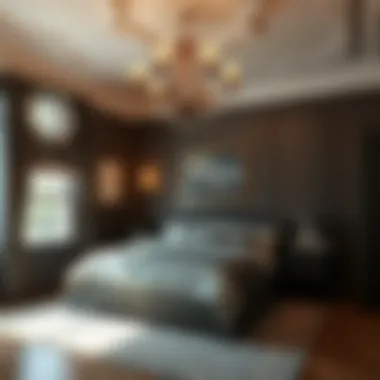
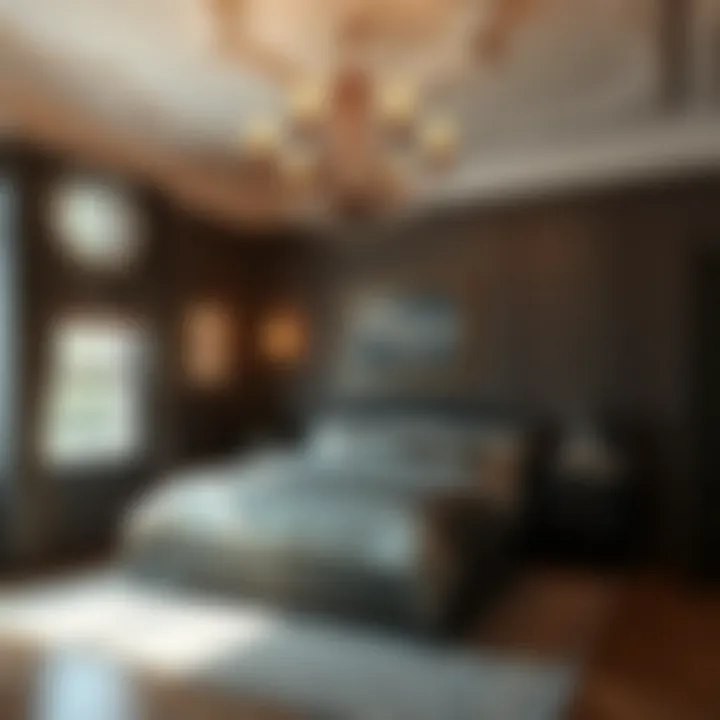
Intro
When it comes to designing a bedroom, the colors you choose can truly set the tone for your space. Light paint colors, in particular, hold a unique power; they can create an inviting atmosphere, evoke feelings of calm, and visually expand smaller areas. This exploration breaks down how selecting the right hues can transform your personal retreat into a haven of tranquility. Whether aiming to achieve a minimalist aesthetic or embracing a cozy rustic feel, this guide aims to illuminate choices that align with both practicality and style.
Color plays a crucial role in how we feel about our surroundings, influencing everything from our moods to our overall well-being. Bedrooms, often deemed our sanctuary, deserve thoughtful consideration when it comes to paint colors. For house owners and housewives seeking a serene environment, understanding light colors and their effects will facilitate more informed decisions.
This piece will provide in-depth insights into trending styles like modern minimalism and cozy rustic, along with color palettes that blend calming neutrals with bold accents. By grasping the nuances of light paint colors, readers can curtail anxiety and enhance their relaxation, ensuring that their bedrooms are not just aesthetically pleasing but also serve as personal retreats.
Understanding Color Psychology
Color plays a crucial role in our lives, often influencing our mood and behavior without us even realizing it. This section aims to delve into the intricate relationship between color and psychology, shedding light on how various hues can transform a space, especially one as intimate as a bedroom. Understanding color psychology isn't just an academic exercise; it's a practical approach that can lead to a more harmonious and soothing environment.
The Impact of Color on Mood
Colors can evoke specific feelings and reactions from those who experience them. Warm colors, like reds and yellows, tend to stimulate and energize, while cooler shades, such as blues and greens, promote tranquility and relaxation.
For instance, imagine walking into a room painted in a vibrant orange. One might feel a rush of energy and enthusiasm, but the same effect can quickly topple if you’re in a bedroom where you'd prefer to unwind. Conversely, soft sky blue or light lavender can envelop you, fostering a sense of calm conducive to restful sleep.
"When you turn the light up in a room with softer shades, it warms the space, creating an inviting atmosphere that draws you in and makes you feel at home."
It’s essential to recognize how colors can affect not just the ambience of the room, but also your personal well-being. Choosing the right shades is a step toward building the mood you desire in your sanctuary.
Colors and Emotional Responses
Beyond general impressions, individual experiences also shape how we respond to colors. The emotional connections we form with certain colors often stem from cultural backgrounds, personal memories, or even popular trends.
For example, many people associate the color green with nature, growth, and renewal. This makes it particularly appealing when aiming to create a serene space that promotes relaxation. Additionally, light pinks have been known to create feelings of affection and intimacy, making them perfect for bedrooms where couples rest.
When picking out paint colors for your bedroom, it’s a good idea to examine your reactions to different shades. Here are a few emotional associations typically connected with colors:
- Light Blue: Calmness, serenity, comfort
- Soft Green: Healing, balance, freshness
- Pale Yellow: Joy, hope, cheerfulness
- Lavender: Harmony, peace, introspection
Engaging with colors on an emotional level rather than purely aesthetic can revolutionize how you design your space. It encourages you to tailor your bedroom to fit not only your style but also your mental and emotional needs, fostering a genuine sense of peace and comfort.
Choosing the Right Light Colors
Choosing the right light colors for a bedroom is not just about following trends or picking the latest shades from paint swatches. It's a careful consideration that can completely change the atmosphere of the space. This section delves into essential elements that must be taken into account alongside their benefits and considerations.
Light colors can brighten up a room, creating an illusion of space, while darker colors may make a room feel more intimate but can also make it appear smaller. When selecting light paint colors, one ought to think about how these shades will interact with the bedroom’s design elements, its purpose, and, most importantly, the way they’ll affect one’s mood. The right choice can evoke feelings of tranquility, uplift one’s spirits, or inspire creativity.
Here are a few key considerations to keep in mind when picking light colors for your bedroom:
- Mood Influence: Different colors can invoke various feelings. A soft blue might promote peace, while a pale yellow can radiate warmth and energy.
- Light Reflection: Lighter tones often reflect more light, making the room feel airy. This aspect is crucial as bedrooms are spaces for relaxation.
- Cohesion With Other Elements: How do the light colors coordinate with existing furniture, flooring, and decor? Finding harmony can enhance the overall aesthetic.
- Trends vs. Timeless Choices: Following trends can be tempting. However, timeless colors tend to provide longevity in design appeal.
Taking these elements into account leads to an informed choice that aligns with both personal taste and the functional needs of the bedroom.
Evaluating Your Space’s Natural Light
When it comes to painting a bedroom, the volume and quality of natural light can significantly influence the final outcome. Every room is different; assessing how sunlight enters the bedroom during different times of the day is vital. Take a moment each day to observe:
- Morning Light: Does bright sunlight stream in, bathing the space in a warm glow?
- Afternoon Shadows: Does the sunlight cast long shadows and cool tones across the room?
- Evening Ambiance: How does the light change as day turns to night, and what color temperatures are most present?
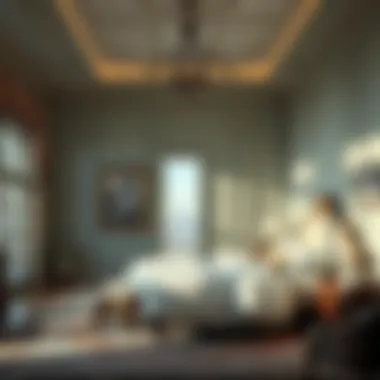
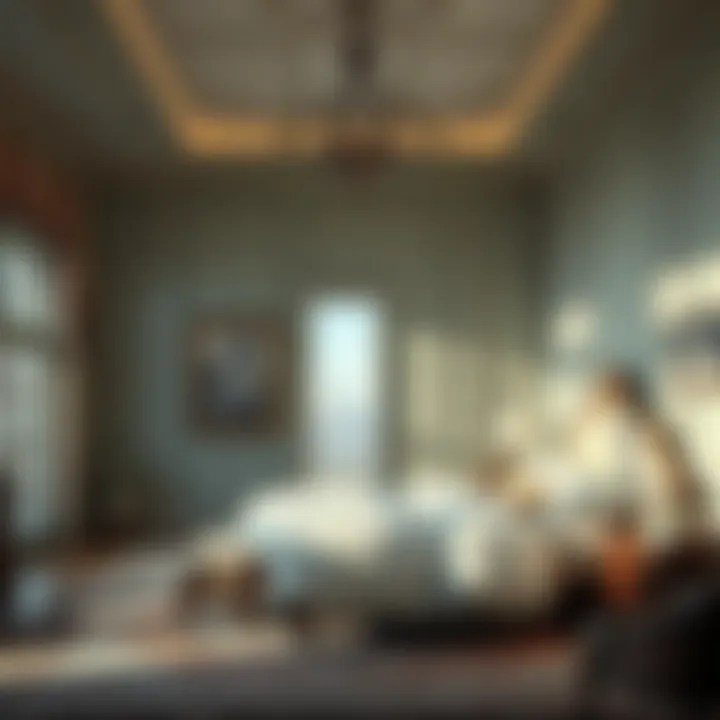
A room drenched in sunlight allows for lighter colors, such as soft yellows or creamy whites, to shine without overwhelming the senses. In contrast, a room that receives limited natural light might benefit from cooler tones like soft blues or greens to mimic a sense of openness and brightness.
"Natural light alters perception. What appears as a crisp white during midday can take on a different hue when lit by the soft glow of dusk."
This understanding of light creates an opportunity for homeowners to play with colors that maximize what’s available, ensuring the space feels alive and inviting.
Considering Room Dimensions and Layout
The size and layout of a bedroom can shape the decision on paint colors. A compact space, for instance, can feel constrictive with darker tones, while light colors can create an appearance of more spaciousness. Here are some tips to consider:
- Small Rooms: Light paint colors like soft whites and pale pastels can seamlessly enhance the perception of space, making the area feel larger than life.
- High Ceilings: A tall room may benefit from lighter walls to bring warmth down; consider a slightly darker accent wall to add dimension without closing the space in.
- Room Shape: Long, narrow rooms can feel more balanced by using lighter colors on the longer walls and a slightly darker shade on the shorter walls as a visual anchor.
By carefully analyzing the dimensions and layout, one can choose colors that will not only heighten the aesthetic appeal but also enrich the functionality of the bedroom space.
In summary, picking the right light colors is about understanding the interplay between light, space, and emotional impact. It sets the stage for a bedroom that feels just right—a space that provides comfort and tranquility.
Popular Light Paint Colors
When it comes to selecting paint colors for your bedroom, opting for popular light paint colors is not just about aesthetics; it’s a matter of creating an inviting atmosphere that promotes relaxation and enhances space perception. Light colors are like a whisper in a busy world — they set a gentle tone and encourage peace. These shades reflect light, making the room feel more spacious and airy, so they are especially beneficial in smaller areas. The choices you make in this category can significantly influence your overall design scheme and your mood when you step into the room after a long day.
Soft Whites and Off-Whites
Soft whites and off-whites are timeless choices that can elevate the vibe of any bedroom. These colors create a bright and open feel while serving as a blank canvas that can be complemented with bold accents. One of the key characteristics of off-white shades is their versatility. You can dress them up or down, making them adaptable to various styles, whether your bedroom leans more modern or rustic. Notably, a soft white paint can amplify natural light, illuminating corners that often go unnoticed.
However, it’s essential to choose the right undertones. Some soft whites lean toward yellow or pink, while others can come across as bluish or grayish. This can impact how the color interacts with your furniture and decor, so testing samples on your walls in different lighting can help ensure you select the right shade.
Pastel Hues: A Gentle Touch
Pastel hues are a wonderful way to bring a soft, inviting feel into your bedroom. These colors are not overwhelming; they create an atmosphere as gentle as a summer breeze. Let’s delve into three specific shades that have gained popularity in recent years.
Light Blues
Light blues evoke a sense of calm and tranquility. This color choice is often associated with clear skies and serene waters, which makes it a soothing backdrop for a bedroom environment. The most beneficial aspect of light blues is their ability to create a peaceful retreat. They tend to promote relaxation and even improve sleep quality in some individuals. One unique feature of light blue is its versatility in pairing with both warm and cool colors, allowing for rich decorating possibilities.
However, it's worth noting that in poorly lit spaces, light blue can appear grayish, which might reduce its cheerful effect. A smart move is to assess how the light tones interact with your room throughout the day.
Soft Pinks
Soft pinks add a touch of warmth and romance, making them a favored choice for master bedrooms or guest rooms. This delicate shade is soft enough not to overwhelm but vibrant enough to breathe life into your space. The key characteristic of soft pink is its ability to create a nurturing environment. It's like wrapping yourself in a cozy blanket after a long day. Its unique feature is that it can soften harsh lines and sharp angles in the room, thus generating a more harmonious feel.
Nevertheless, when opting for soft pinks, it's important to be cautious with the amount of natural light in the room. Too much sunlight can make the color more jarring, so a north-facing room may not showcase soft pinks as well as those with more moderate amounts of light.
Mint Greens
Mint greens are a refreshing choice that carries a hint of cheerful energy. This shade can instill an uplifting sense without being too bold. Mint green is often associated with renewal and freshness, which is why many homeowners are drawn to it for their bedrooms. Its mild and cool tone is excellent for creating a serene backdrop, ideal for unwinding after a hectic day.
What sets mint greens apart is their adaptability; they can pair beautifully with earthy browns or crisp whites, allowing for both a modern and a classic feel. However, be wary of its cooler undertones, which may clash with warmer color palettes if not thoughtfully integrated.
Tranquil Neutrals for a Calming Atmosphere
In addition to pastels, tranquil neutrals are a go-to for creating a peaceful sanctuary. Neutrals like beige, greys, and taupe offer an understated elegance that portrays comfort and stability. They create a harmonious balance that allows personal style to shine through without the colors fighting for attention.
Beige
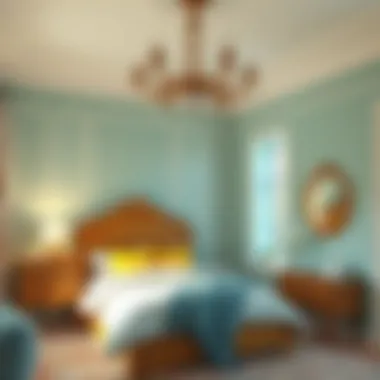
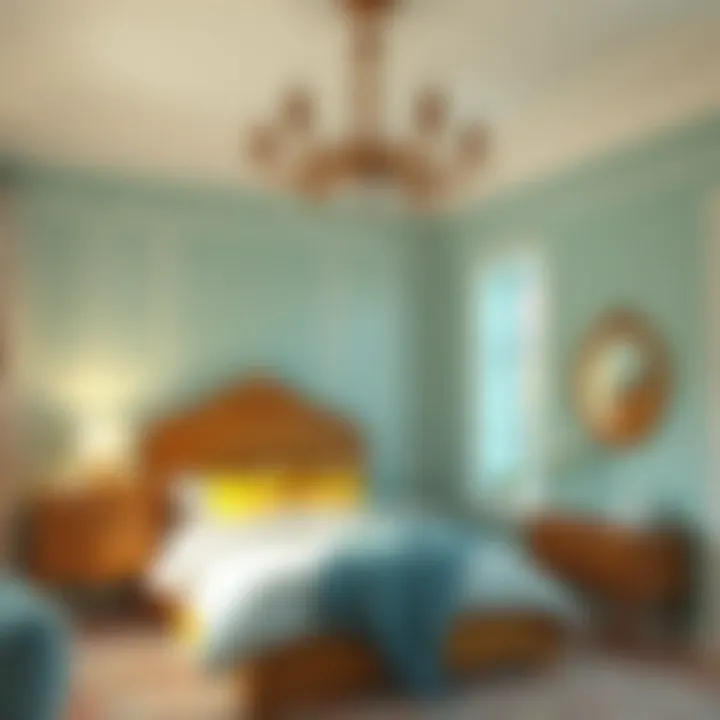
Beige brings warmth and coziness to a room, making it feel inviting and comfortable. This color is like a cup of cocoa on a winter evening; it wraps you up in calmness. It’s often regarded as a staple in interior design due to its versatility. Beige can pair beautifully with almost any accent color, making it easy to change your decor style without needing a fresh coat of paint. However, depending on the lighting, beige can sometimes appear yellowish, losing some of its charm.
Greys
Greys offer a sleek, sophisticated look that can fit any style. Their subtlety allows for layering with various textures and colors, giving a very polished vibe to the space. Light greys can evoke feelings of calm, much like a foggy morning. They serve as an excellent backdrop for bolder furniture or decor pieces. One consideration, though, is that greys can sometimes feel a bit cold without warm accents to balance them.
Taupe
Taupe provides an interesting mix of gray and brown, creating a rich, earthy tone that grounds a bedroom. This neutral does a fantastic job of adding depth to a room without overpowering it. It’s often seen as a bridge between light and dark colors, providing flexibility in design choices. However, similar to greys, taupe can come off as dull in rooms lacking natural light, so be mindful of the atmosphere you want to create.
In summary, popular light paint colors not only enhance visual aesthetics but also play a crucial role in elevating your mood and promoting relaxation in your sanctuary.
Accent Walls and Light Colors
In the realm of interior design, accent walls have emerged as a popular choice, especially in bedrooms. The beauty of light colors becomes truly pronounced when they pair with accent walls. Accent walls can transform a dull space into a lively and inviting one. When implemented thoughtfully, they provide depth and character, making the room feel more spacious and dynamic. It’s about playing with shades and tones to create a balance that ties the room together, allowing the light colors to shine and maintain harmony.
Enhancing Depth with Accent Walls
Utilizing an accent wall in a bedroom can significantly enhance the perception of depth. For instance, a soft pastel blue on three walls paired with a deeper navy on the accent wall establishes dimension, making the room appear larger than it is. The eye is naturally drawn to the accent wall, creating a focal point that can host elements such as a bed, artwork, or even a stylish bookshelf.
When selecting your accent color, consider the feelings you aim to evoke. A warm peach can bring a coziness that feels inviting, while a muted sage green might instill a sense of tranquility. It’s essential to remember that light colors can harmonize beautifully with darker shades; it’s all in how they are balanced. Ensuring that your chosen light color doesn’t clash with the accent shade will keep the room visually appealing.
Color Pairing for Balance
Pairing colors is a crucial part of establishing a cohesive design narrative. Light colors, with their soft and airy qualities, are often complemented by bolder accents that provide contrast. For example, a light gray backdrop can be skillfully offset by a rich bottle green accent wall, which can bring about a sophisticated yet inviting atmosphere.
Here are some tips for effective color pairing:
- Consider the color wheel: Use complementary colors that sit opposite each other to create stunning contrasts. For light colors, maybe look at pairing soft yellows with muted purples.
- Use analogous colors as a guide: Colors that are next to each other on the wheel can create a sense of calm. Light blue and soft green often work beautifully together.
- Experiment with textures: Incorporating textured elements can further enhance the visual interest of the colors chosen. Think about a sleek wall finish against a matte textured fabric on the bed.
Techniques for Application
Choosing the right paint for a bedroom isn’t just about picking the prettiest shade. The application techniques play a vital role in achieving that wonderful, calming atmosphere you desire. You can splash some paint on and call it a day, but that approach might leave you feeling like you’ve just dropped a ball at a bowling alley; a little chaos without the pins to show for it. On the other hand, understanding and applying effective techniques can make all the difference in your project.
Choosing the Right Finish
Matte vs. Satin
Let’s start with two of the more popular finishes you might consider: matte and satin. The matte finish is like a whisper in a crowded room; it brings a sense of calm and understated elegance to your space. It does a fantastic job of hiding imperfections on walls, making it an excellent choice for older homes or spaces that have seen better days. However, it tends to be less durable against the wear and tear of everyday life.
On the flip side, satin finish is a bit more robust. Think of it as a cozy, warm hug; it offers a delicate sheen that can reflect light, enhancing the brightness of your space. It’s easier to clean compared to matte, making it practical for spaces where there might be occasional splatters or dirt. Both have their strengths, and ultimately, the choice hinges on your lifestyle preferences and aesthetic goals. The trade-off between durability and style often shapes a homeowner’s decision in this realm.
Glossy Accents
When considering glossy accents, we see a different beast emerge. Glossy paint can be a bold choice, and it has its place if you’re on the hunt for that striking focal point to elevate the overall design of your bedroom. Gloss finishes bounce light around the room like a kid with a basketball, making even the smallest space feel larger and brighter, which is something very cosy and inviting.
However, there’s a double-edged sword in play. While they shine brightly and can be very visually appealing, glossy finishes often reveal every blemish or imperfection on the wall. If you opt for glossy accents, just be prepared to touch things up a bit more frequently than with a matte or satin finish. Striking a balance between style and upkeep is crucial in creating that serene bedroom haven.
Prepping Your Walls
Now that we have a sense of what kind of finish to use, let’s not forget about prepping the walls. This might sound like a minor detail, but trust me, it’s anything but. Cleaning the walls to remove dirt and grime before painting sets a solid foundation for your transformation. Think of it as washing your hands before cooking; it’s not the fun part, but it’s essential for a good outcome.
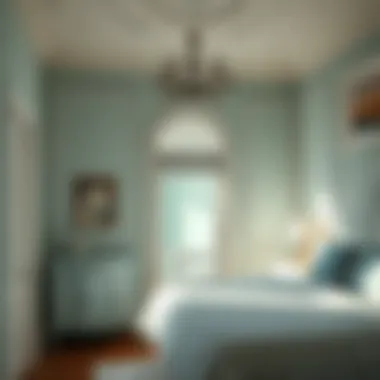
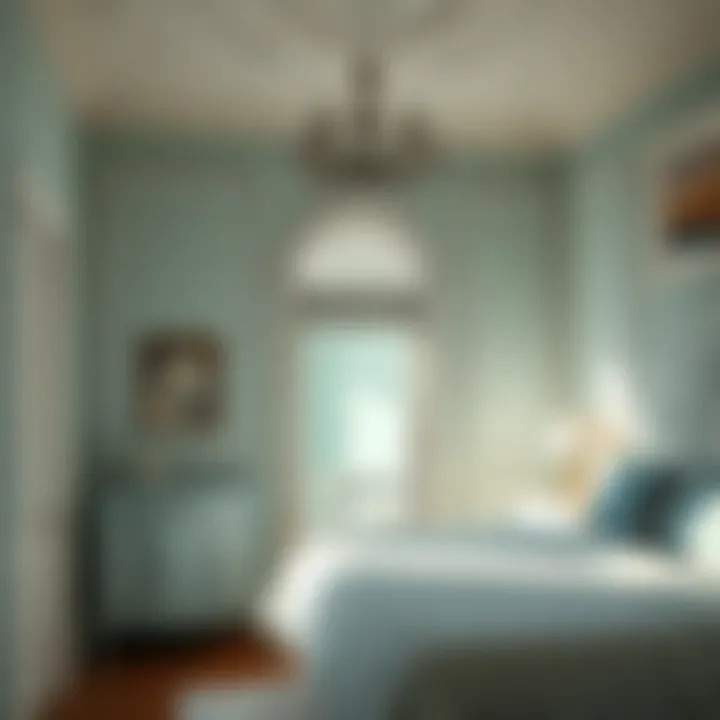
You should also consider patching any holes or painting over stains to ensure an even application throughout. After all, you wouldn’t wear a nice outfit without ironing it first, right? A little effort in the preparation stage leads to stunning results that you’ll be glad to show off.
Remember, a well-prepped wall is like a blank canvas waiting for the masterpiece to come to life.
In summation, the techniques you choose for applying paint can dramatically affect the overall look and feel of your bedroom. By carefully selecting your finishes and ensuring a solid foundation with proper prep work, you’ll be well on your way to creating a space that feels both inviting and polished.
Creating Cohesion in Your Bedroom Design
Designing a bedroom involves much more than just picking a few paint colors and arranging some furniture. Creating cohesion in your bedroom design ensures that your space feels harmonious and connected. This is particularly important because a cohesive design contributes to a sense of comfort and tranquility, which is essential in a place meant for rest and rejuvenation. By taking the time to coordinate colors, styles, and textures, you can transform your bedroom into a serene retreat, where every element complements the other.
Coordinating with Furniture and Textiles
When it comes to coordinating your wall paint with furniture and textiles, think carefully about the materials and colors you choose. Light paint colors work wonders in amplifying the natural light that enters your space, but they also need companions that resonate on a deeper architectural level. For instance, soft whites can be paired with light wood finishes, lending a warm, inviting feel to the room.
- Light Grey Walls: These can seamlessly blend with both dark and light furnishings, making your space feel larger and more balanced.
- Pastel Blue Textiles: When layered over white walls, these can add a touch of color without overwhelming the senses.
- Natural Fabrics: Use linens, cottons, and wools to create an organic flow between your paint colors and textiles. These materials can often enhance light colors, creating an airy atmosphere.
As you select furniture pieces, consider their scale and shape as well. For example, a sleek, modern bed frame in a light wood can beautifully offset shade like soft beige walls, maintaining visual clarity. The juxtaposition of textures—smooth against rough surfaces—lends depth to your space, making it more interesting without being chaotic.
Incorporating Accessories
Accessories, albeit smaller details, play a vital role in achieving cohesion in your bedroom design. They can tie in your color palette and add personality without clashing with your chosen paint colors. Consider carefully curated items that echo the light shades used throughout the room.
- Wall Art: Select pieces that feature light colors and harmonize with your paint choice. Pastel paintings or abstract pieces that incorporate shades from your textiles will keep things consistent and appealing.
- Bedding and Cushions: Invest in soft Ikat patterns or subtle florals that reflect the hues of your wall. This can create a layered look, inviting warmth to your design.
- Rugs: A light, textured rug can help anchor the space while echoing the lightness of your paint colors. Ensure its shades are coordinated with both the wall and furniture, allowing for a seamless blend.
Emphasizing cohesion does not mean sticking to a monotonous palette—rather, it encourages an exploration of shades and textures that resonate with one another. In this way, you can create a sanctuary that feels like a natural extension of who you are.
"A well-coordinated bedroom evokes calm and comfort, inviting you to unwind at the end of the day."
With these principles in mind, take a step back and assess whether your overall design communicates a sense of harmony. Whether you are choosing light pastels or a serene neutral, maintaining cohesion throughout your bedroom can transform it into a space that reflects tranquility and inviting comfort.
Frequently Asked Questions
In any discussion about paint colors, especially in a bedroom setting, common inquiries often surface. It’s crucial to address these frequently asked questions (FAQs) in order to guide home decorators towards making informed decisions that not only enhance aesthetics but also promote emotional wellbeing. These FAQs act as a roadmap, identifying the key concerns of homeowners and offering solutions that resonate with their unique situations.
"Color is a power which directly influences the soul." - Wassily Kandinsky
Understanding your queries can also highlight much about your personal preferences and how you perceive your living environment. As we delve into the specifics of color selection, it’s important to remember that individual taste plays a significant role. The FAQs presented here cover significant aspects like maximizing space, aligning with different decor styles, and how colors can impact the overall vibe of your sanctuary.
What Colors Make a Small Bedroom Look Bigger?
When it comes to creating a spacious feeling in a compact bedroom, paint color choices can work wonders. Light and airy colors truly are your best friends. Shades like soft whites, pale blues, and gentle pastels reflect light and make the walls seem farther away than they actually are, effectively expanding the visual perception of space.
Some options to consider include:
- Sky Blue: Evokes a sense of openness and tranquility, soothing while seeming limitless.
- Pale Lemon Yellow: Brightens the room without overwhelming it, adding a splash of cheerfulness that also feels spacious.
- Soft Grays: These can open up a room while keeping it modern and sophisticated, creating a tranquil backdrop.
In addition to color choices, keep in mind the finish of your paint. A satin or semi-gloss finish reflects more light than matte, giving an added illusion of space. Light colors combined with reflective surfaces like mirrors or glossy furniture can heighten this effect even further.
How to Choose Colors Based on my Bedroom's Style?
Choosing paint colors based on your existing bedroom style is not just about aesthetics; it’s about maintaining harmony within the space. Well-coordinated colors can enhance the character of your bedroom while making it feel cohesive. Start by assessing the existing elements of your room, including:
- Furniture: What colors dominate your furniture? A muted palette can be complemented with softer tones in your paint.
- Textiles: Bedding, curtains, and rugs play significant roles. Use a paint color that echoes hues found in these textiles to create a unified look.
- Natural Elements: If your bedroom has wooden features, try to lean towards colors that either complement or contrast gently with the wood's tone.
Here are steps to take:
- Identify the Base Color: Determine the dominant color in your textiles.
- Select Your Main Paint Color: Choose a matching or complementary tone that will enhance the base color.
- Consider Accents: Look for a contrasting or complementary accent color for smaller areas or furniture.
This thoughtful approach not only enhances aesthetic appeal but also creates an inviting atmosphere that feels tailored just for you. By following these guidelines, selecting the right colors becomes a creative and fulfilling process, resulting in a tranquil retreat that aligns with your personal taste.















